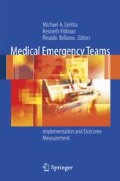Access this chapter
Tax calculation will be finalised at checkout
Purchases are for personal use only
Preview
Unable to display preview. Download preview PDF.
References
Abel-Smith B. The Hospitals 1800–1948. London: Heinemann; 1964.
Brennan TA, Leape LL, Laird N, et al. Incidence of adverse events and negligence in hospitalized patients: results of the Harvard Medical Practice Study I. N Engl J Med. 1991;324:370–376.
Leape LL, Brennan TA, Laird N, et al. Nature of adverse events in hospitalized patients: results of the Harvard Medical Practice Study II. N Engl J Med. 1991;324:377–384.
Wilson RM, Runciman WB, Gibberd RW, et al. The quality in Australian health care study. Med J Aust. 1995;163:458–471.
Hillman KM, Bristow PJ, Chey T, et al. Antecedents to hospital deaths. Intern Med J. 2001;31:343–348.
Schein RMH, Hazday N, Pena M, et al. Clinical antecedents to in-hospital cardiopulmonary arrest. Chest. 1990;98:1388–1392.
Hillman KM, Bristow PJ, Chey T, et al. Duration of life-threatening antecedents prior to intensive care admission. Intensive Care Med. 2002;28:1629–1634.
McQuillan P, Pilkington S, Alan A, et al. Confidential inquiry into quality of care before admission to intensive care. BMJ. 1998;316:1853–1858.
Goldhill DR, White SA, Sumner A. Physiological values and procedures in the 24 hours before ICU admission from the ward. Anaesthesia. 1999;54:529–534.
McGloin H, Adam SK, Singer M. Unexpected deaths and referrals to intensive care units of patients on general wards: are some cases potentially avoidable? J Royal Coll Physicians Lond. 1999;33:255–259.
Hillman K, Parr M, Flabouris A, Bishop G, Stewart A. Redefining in-hospital resuscitation: the concept of the medical emergency team. Resuscitation. 2001;48:105–110.
Bion JF, Heffner JE. Challenges in the care of the acutely ill. Lancet. 2004;363: 970–977.
Kohn LT, Corrigan JM, Donaldson MS, eds. To Err Is Human: Building a Safer Health System. Washington, DC: National Academies Press; 2000.
Vincent C, Neale G, Woloshynowych M. Adverse events in British hospitals: preliminary retrospective record review. BMJ. 2001;322:517–519.
Shaw C, Coles J. Reporting of adverse clinical incidents: international views and experience. London: CASPE Research; 2001.
Baker GR, Norton P. Patient safety and healthcare error in the Canadian healthcare system: a systematic review and analysis of leading practices in Canada with reference to key initiatives elsewhere. Report to Health Canada. 1964. Available at: http://www.hc-sc.gc.ca/english/care/report/index.html. Accessed January 2004.
Shojania KG, Duncan BW, McDonald KM, et al. Making Health Care Safer: A Critical Analysis of Patient Safety Practices. Rockville, MD: Agency for Healthcare and Research Quality; 2001.
Intercollegiate Board for Training in Intensive Care Medicine. Available at: http://www.ics.ac.uk. Accessed January 2004.
Estrada CA. Medical errors must be discussed during medical education. BMJ. 2000;321:507.
Leape L. Reporting of adverse events. N Engl J Med. 2002;347:1633–1638.
Classen DC, Kilbridge PM. The roles and responsibility of physicians to improve patient safety within health care delivery systems. Acad Med. 2002;77:963–972.
Leapfrog patient safety standards. Leapfrog Group Web site. Available at: http://www.leapfroggroup.org. Accessed January 2004.
Bates DW, Teich JM, Lee J, et al. The impact of computerized physician order entry on medication error prevention. J Am Med Inform Assoc. 1999;6:313–321.
Dexter PR, Perkins S, Overhage JM, Maharry K, Kohler RB, McDonald CJ. A computerized reminder system to increase the use of preventive care for hospitalized patients. N Engl J Med. 2001;345:965–970.
Kilbridge P. Computer crash: lessons from a system failure. N Engl J Med. 2003;348:881–882.
Wachter RM, Goldman L. The emerging role of “hospitalists” in the American health care system. N Engl J Med. 1996;335:514–517.
Lee A, Bishop G, Hillman KM, Daffurn K. The Medical Emergency Team. Anaesth Intensive Care. 1995;23:183–186.
Hourihan F, Bishop G, Hillman KM, Daffurn K, Lee A. The Medical Emergency Team: a new strategy to identify and intervene in high-risk patients. Clin Intensive Care. 1995;6:269–272.
Hillman KM ed. Redefining resuscitation. Aust NZ J Med. 1998;28:759.
Hillman KM. Reducing preventable deaths and containing costs: the expanding role of intensive care medicine. Med J Aust. 1996;164:308–309.
Hillman K. A hospital-wide system for managing the seriously ill. Minerva Anestesiologica. 1999;65:346–347.
McNutt R, Abrams R, Hasler S. Why blame systems for unsafe care? Lancet. 2004;363:913–914.
Pande PS, Neuman RP, Cavanagh RR. The Six Sigma Way: How GE, Motorola, and Other Top Companies Are Honing Their Performance. New York: McGraw-Hill; 2000.
Berwick DM. Errors today and errors tomorrow. N Engl J Med. 2003;348:2570–2572.
McNutt RA, Abrams R, Hasler S. Patient safety efforts should focus on medical error. JAMA. 2002;287:1997–2001.
Cleghorn GD, Headrick LA. The PDSA cycle at the core of learning in health professions’ education. Jt Comm J Qual Improv. 1996;22:206–212.
World Health Organization. World Alliance for Patient Safety: Forward Programme. 2004. Available at: http://www.who.int/patientsafety/en/brochure_final.pdf
Author information
Authors and Affiliations
Editor information
Editors and Affiliations
Rights and permissions
Copyright information
© 2006 Springer Science+Business Media, Inc.
About this chapter
Cite this chapter
Hillman, K., Chen, J., Young, L. (2006). The Evolution of the Health Care System. In: DeVita, M.A., Hillman, K., Bellomo, R. (eds) Medical Emergency Teams. Springer, New York, NY. https://doi.org/10.1007/0-387-27921-0_2
Download citation
DOI: https://doi.org/10.1007/0-387-27921-0_2
Publisher Name: Springer, New York, NY
Print ISBN: 978-0-387-27920-6
Online ISBN: 978-0-387-27921-3
eBook Packages: MedicineMedicine (R0)

